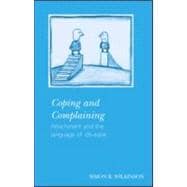
Note: Supplemental materials are not guaranteed with Rental or Used book purchases.
Purchase Benefits
Looking to rent a book? Rent Coping and Complaining: Attachment and the Language of Disease [ISBN: 9781583911709] for the semester, quarter, and short term or search our site for other textbooks by Wilkinson,Simon R.. Renting a textbook can save you up to 90% from the cost of buying.
| List of boxes | p. xi |
| Preface | p. xiii |
| Acknowledgements | p. xvi |
| List of abbreviations | p. xvii |
| 'I'm ill; you're sick' | p. 1 |
| Illness | p. 5 |
| Sickness | p. 6 |
| Disease and disorder | p. 7 |
| Predicament | p. 9 |
| Illness behaviour and strategic symptoms | p. 10 |
| Attachment paradigm | p. 11 |
| A psychosocial classification of disease | p. 13 |
| Why, how and what? | p. 16 |
| Notes | p. 18 |
| Genes, brain and the internal milieu: Our limits and resources | p. 20 |
| Genes | p. 21 |
| Family influences and brain growth | p. 23 |
| Emotions and neurotransmitters: the foundations for feeling ill | p. 28 |
| Brain localisation and the somato-sensory areas | p. 37 |
| Stress - tipping the balance | p. 40 |
| Attachment and the developing brain | p. 44 |
| Conclusion | p. 46 |
| Notes | p. 47 |
| Learning and memory: A basis for understanding development and change in the face of threat and danger | p. 52 |
| Memory | p. 53 |
| Information presentation to memory | p. 67 |
| Social development | p. 72 |
| Conclusion | p. 85 |
| Notes | p. 86 |
| The ideal patient: The 'balanced' type B attachment strategies | p. 89 |
| Attachment and the danger of disease | p. 92 |
| Adulthood and the balanced (secure) type B classification | p. 98 |
| Childhood and the balanced (secure) type B classification | p. 108 |
| The ideal illness language | p. 113 |
| Notes | p. 115 |
| 'I'm OK; don't worry about me.' The 'dismissing' type A attachment strategies | p. 118 |
| Adulthood, parenting and the dismissing type A classification | p. 119 |
| Childhood and the dismissing type A classification | p. 136 |
| Risk, danger and insecurity | p. 140 |
| The dismissing cognitive illness dialogue | p. 149 |
| Some provisional implications for clinical practice and health promotion: compliance and collaboration | p. 160 |
| Notes | p. 163 |
| 'My pain is really terrible. What are you going to do about it?': The 'preoccupied' type C attachment strategies, and other classifications | p. 164 |
| Adulthood, parenting and the preoccupied type C classification | p. 166 |
| Childhood and the preoccupied type C classification | p. 194 |
| Risk and preoccupation | p. 197 |
| The preoccupied affective illness dialogue | p. 199 |
| Some provisional implications for clinical practice and health promotion: collaboration and conflict | p. 205 |
| Notes | p. 209 |
| Ambiguous symptoms and the attachment strategies of health professionals | p. 212 |
| Ambiguous symptoms | p. 216 |
| The attachment strategies of health professionals | p. 230 |
| Notes | p. 241 |
| Goal-corrected partnerships for health | p. 246 |
| Healthcare systems | p. 247 |
| Goal corrected partnerships | p. 252 |
| Gender | p. 268 |
| Culture | p. 271 |
| Notes | p. 277 |
| Glossary | p. 283 |
| References | p. 287 |
| Index | p. 313 |
| Table of Contents provided by Ingram. All Rights Reserved. |
The New copy of this book will include any supplemental materials advertised. Please check the title of the book to determine if it should include any access cards, study guides, lab manuals, CDs, etc.
The Used, Rental and eBook copies of this book are not guaranteed to include any supplemental materials. Typically, only the book itself is included. This is true even if the title states it includes any access cards, study guides, lab manuals, CDs, etc.